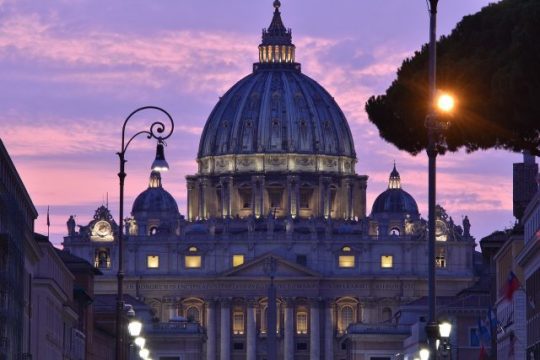The Vatican is often seen as a beacon of faith and tradition, but its history is rich with hidden tales of power, intrigue, and mystery. In 10 untold stories whispered through the Vatican’s history, we uncover the lesser-known chapters of this iconic institution. From the Vatican’s secretive archives to the controversial trials and political maneuverings, these stories shed light on the complex past of the Vatican. Explore the forgotten events that shaped its influence on both religion and world history, offering a new perspective on this ancient institution.
10. The Vatican’s Celestial Observatory and Arizona Telescope
The Vatican’s Celestial Observatory, one of the world’s oldest, and its modern telescope in Arizona reveal a surprising truth—this spiritual center has long embraced science. The Vatican Advanced Technology Telescope (VATT), nestled on Mount Graham, allows its astronomers to study distant galaxies, merging faith with cutting-edge research.
But beyond the stars, deeper mysteries remain. Within the secretive Vatican Apostolic Archive lie untold stories—hidden letters, forbidden manuscripts, and records of historic events from Galileo’s trial to the secrets of Fatima. These whispered histories challenge what we think we know about the Church’s role in science, politics, and global affairs.
As scholars and digital archivists continue to uncover these secrets, a new image of the Vatican emerges: not just a guardian of faith, but a vault of forgotten truths waiting to be explored.
9. Allegations of Vatican Involvement in Post-WWII “Ratlines”
After World War II, the Vatican became embroiled in allegations surrounding the “Ratlines“—a network of escape routes that helped Nazi officials and war criminals flee Europe, primarily to South America. These routes were believed to have been facilitated by a mix of sympathetic individuals, including some Church officials. The controversy arises from claims that the Vatican played a more active role than previously acknowledged, offering protection to certain individuals escaping justice.
The most well-known of these allegations point to high-ranking members of the Vatican who, for various reasons, may have helped Nazi war criminals escape Allied retribution. Many suggest that the Vatican’s involvement was driven by anti-Communist sentiment, as well as a desire to protect certain figures in the chaos of the post-war period. While these claims remain disputed, they continue to captivate the imaginations of historians and conspiracy theorists alike.
Questions still persist about what is hidden in the Vatican archives. Could the documents detailing the Vatican’s potential involvement in these secretive operations still be locked away, waiting to be uncovered? The full extent of the Vatican’s role in these post-war events remains unclear, as researchers continue to delve into these dark and controversial chapters of history.
8. Emergency Funding for a Papal Election
In 1922, the Vatican faced a financial crisis during the papal election following the death of Pope Benedict XV. With insufficient funds to cover the conclave’s costs, emergency funding was quickly arranged, marking a rare moment in the history of the Vatican when financial struggles nearly disrupted the election process.
The Vatican turned to various sources, some controversial, to secure the necessary funds. This situation raised questions about the Church’s financial transparency and its relationship with powerful figures who may have influenced the outcome.
While the election proceeded smoothly, the incident remains a reminder of the Vatican’s complex financial and political landscape during this turbulent period.
7. Rome Without the Pope: The Neglect During the Avignon Papacy
From 1309 to 1377, the Papacy was moved from Rome to Avignon, France, a period known as the Avignon Papacy. During this time, Rome was neglected, and the city’s once-vibrant religious and political center began to deteriorate. The absence of the Pope in Rome left a power vacuum, with the city struggling both economically and spiritually.
This era is one of the untold stories of the Vatican’s history, as it highlights the complexities and challenges the Church faced in maintaining its influence and authority without the presence of the Papal leadership. As the Popes resided in France, Rome fell into disrepair, and many of its important institutions, including the Vatican itself, suffered from neglect.
When the Papacy finally returned to Rome in 1377, the city faced monumental challenges. The restoration of its political and religious significance marked the beginning of a long rebuilding process, but the shadow of neglect during the Avignon Papacy looms large in Vatican history.
6. The Vatican Hill’s Pagan and Bloody Past
Before it became the heart of Christianity, Vatican Hill in Rome was a site steeped in pagan rituals and bloodshed. In ancient times, the hill was home to temples dedicated to various gods, and it was also the site of public executions, including those of early Christian martyrs. The most famous of these was Saint Peter, who was crucified there during the reign of Emperor Nero, an event that eventually led to the construction of St. Peter’s Basilica.
The history of Vatican Hill is a far cry from the peaceful sanctity we associate with the Vatican today. Secrets buried beneath the Vatican suggest that this site was once a place of power and brutality, with its past intertwined with both pagan and Christian legacies. The transformation from a pagan hill to the center of Christianity was not just symbolic but rooted in a violent and bloody past that remains part of the Vatican’s deeper history.
The blending of these ancient and sacred elements continues to add to the mystique surrounding the Vatican, where layers of history, both divine and grim, coexist beneath its sacred surface.
5. The Apostolic Penitentiary: The Ancient Court of Conscience
The Apostolic Penitentiary, established in the 12th century, is one of the Vatican’s oldest institutions. Known as the “Court of Conscience,” it addresses matters of spiritual significance, such as absolution, indulgences, and the remission of sins. Unlike other Vatican courts, its focus is purely on moral and spiritual decisions.
Although largely hidden from public view, Vatican historical revelations suggest that the Apostolic Penitentiary has handled some of the most sensitive cases in Church history. From reconciling high-profile individuals to managing secret confessions, the institution plays a powerful yet discreet role in shaping the spiritual lives of many.
This ancient court remains shrouded in mystery, preserving untold stories of faith, forgiveness, and the Church’s complex relationship with sin.
4. The “Secret” Archives Were Always Just “Private”
The Vatican’s “Secret” Archives have long been a source of intrigue, but they were never truly secret—just private. The archives contain centuries of documents related to the Church’s activities, from official papal letters to important historical records. The term “secret” comes from the Latin word “secretum,” meaning “private,” rather than hidden or forbidden.
As part of the broader history of Vatican City, these archives have been used for administrative purposes, not to conceal scandals. While access was restricted, the idea of mystery surrounding them has often been exaggerated. The archives are a rich resource for scholars seeking to understand the Church’s past, offering insight into its political, religious, and social roles throughout history.
3. The Chinon Parchment and the Absolution of the Knights Templar
The Chinon Parchment, discovered in the Vatican Apostolic Archives in 2001, revealed a shocking piece of history. It documented the absolution of the Knights Templar by Pope Clement V in 1308, shortly before the order was officially disbanded. This parchment contradicted the widely accepted narrative that the Templars were excommunicated and condemned for heresy.
The document showed that the Pope had granted the Templars absolution, clearing their names of the charges leveled against them by King Philip IV of France. Despite this, the order was dissolved, and its members persecuted. The discovery of the Chinon Parchment opened a new chapter in the mysterious history of the Knights Templar, raising questions about the true motives behind their downfall.
2. The Saracen Attack: When St. Peter’s Was Raided
In 846 AD, Rome was struck by a devastating Saracen raid. Muslim forces, known as the Saracens, attacked the city, plundering St. Peter’s Basilica and desecrating the tomb of St. Peter. This attack was one of the most significant assaults on the Vatican in its history.
The Saracens pillaged sacred treasures, leaving behind a trail of destruction. Although the Vatican managed to rebuild, the raid served as a stark reminder of the vulnerabilities even the holiest site in Christianity faced during this turbulent period. The event also led to increased fortifications around St. Peter’s, marking a turning point in the protection of the Vatican.
1. The Cadaver Synod: A Posthumous Trial of a Pope
One of the most bizarre and macabre events in Vatican history occurred in 897 AD: The Cadaver Synod. Pope Stephen VI put the body of his predecessor, Pope Formosus, on trial, after Formosus had died and been buried. The deceased pope’s body was exhumed, dressed in papal vestments, and propped up on a throne while a deacon was appointed to speak on his behalf.
Formosus was posthumously found guilty of perjury, ambitiousness, and other charges, and his papacy was declared invalid. His corpse was stripped of its papal garments, and his fingers, used for blessing, were cut off. This bizarre trial shocked the Christian world and remains one of the most infamous episodes in papal history, illustrating the intense political rivalries and corruption of the time.



